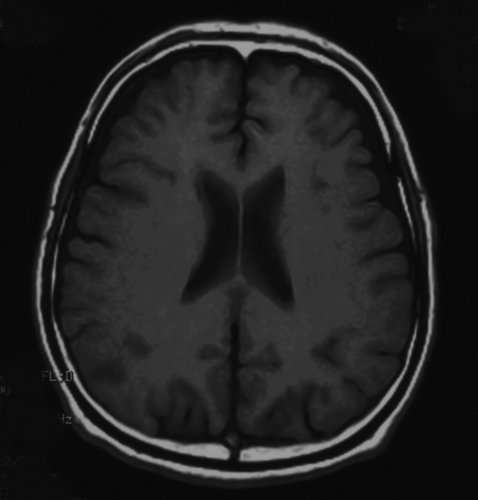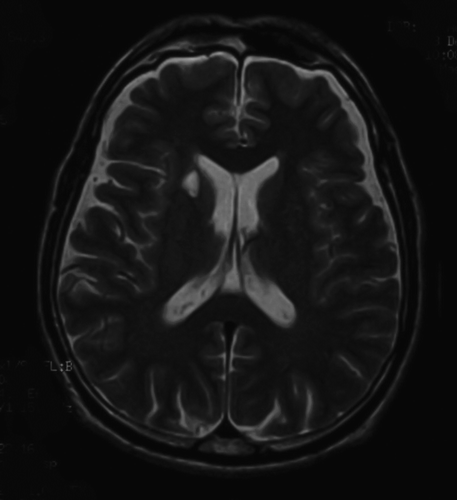Abstract
We describe a case of catatonia in a 51-year-old man in whom the catatonic symptoms could not be distinguished from symptoms of frontotemporal dementia (FTD) until they were resolved with electroconvulsive therapy (ECT). When it is difficult to distinguish between catatonia and FTD in patients with frontal dysfunction associated with frontal lobe atrophy, we believe that sequential administration of benzodiazepines and ECT is important for therapeutic diagnosis because the risk of missing a diagnosis of catatonia outweighs the risks associated with administration of benzodiazepines and/or ECT.
Introduction
Clinical recognition of catatonia is important because there are specific and definitive treatments, i.e. benzodiazepines (BZPs) and electroconvulsive therapy (ECT) (Fink and Taylor Citation2003). Catatonia is sometimes difficult to differentiate from frontotemporal dementia (FTD) because some of the symptoms overlap (Neary et al. Citation1998; Fink and Taylor Citation2003). We describe a catatonic patient whose symptoms could not be distinguished from symptoms of FTD until they were resolved with ECT.
Case report
The patient was a 51-year-old man. His premorbid personality was characterized by assiduousness and syntony. There was no family history of mental or neurological disorders. At 48 years of age, the patient gradually began to exhibit inappropriate facial expressions and eccentric behaviour. He became easily angered and joked inappropriately. He did not care about his appearance or legal obligations (e.g., he did not seek to replace missing anterior teeth, he did not visit a barbershop for 1 year, and he drove his car with an expired license). At 50 years of age, he began to crave sweets, have an enormous appetite and shrink from taking a bath. One day, at 51 years of age, he skipped work without excuse. He appeared the next day and expressed thoughts of suicide. He was admitted to a psychiatric hospital because of the suicidal thoughts, anxiety and perplexity. His wife reported that he had become gloomy 1 month before admission to the hospital. He exhibited aspontaneity, agitation, disorientation to time and apprehension about a debt that had in fact already been paid, and he repeatedly demanded sweets. He did not differentiate between his own belongings and those of others. He took the belongings of other patients without guilt, and thus isolation was required. Neuroleptics (olanzapine 10 mg/day and quetiapine 700 mg/day), antidepressants (fluvoxamine 150 mg/day, milnacipran 225 mg/day and lithium 600 mg/day), BZPs (cloxazolam 6 mg/day, diazepam 15 mg/day, flunitrazepam 2 mg/day and nitrazepam 10 mg/day) did not improve his symptoms.
Five months after admission, the patient was transferred to Tohoku University Hospital for evaluation of the atypical symptoms. Detailed examination including blood tests, neurological examination, electroencephalography, and magnetic resonance imaging (MRI) of the brain revealed no abnormalities except age-inappropriate diffuse frontal lobe atrophy and an old lacunar infarction in the right caudate nucleus ( and ). The patient's Mini Mental State Examination (MMSE) score was 23. Evaluation of higher brain function revealed no aphasis, constructive apraxia or agnosia. There was some mild disturbance of recent memory. His attention span was very limited, and he tired of the examinations. With respect to abstract thinking, he could repeat proverbs, but he could not understand their deep meanings. The patient repetitively lifted his heel against the door of his room while lying on the floor. He usually became fixated on something (e.g., ballpoint pen or name of a staff member). He sometimes spoke politely and formally without expression even to his wife, and he demanded food. He entered the staff room without asking, took everything in sight and saluted the onlookers. Intravenous midazolam (20 mg) did not change his behaviour. Single photon emission computed tomography study could not be undertaken because of his restlessness.
Figure 1. T1-weighted magnetic resonance image. Mild diffuse age-inappropriate brain atrophy is seen in the frontal lobe.

Figure 2. T2-weighted magnetic resonance image. Old lacunar infarction is seen in the right caudate nucleus.

There were two possible diagnoses. The first was FTD because the onset was insidious and the patient showed a gradual decline in social and interpersonal behaviour, impaired regulation of personal conduct, emotional blunting, loss of insight, distractibility, dietary changes, stereotyped behaviour and speech, aspontaneity and frontal lobe atrophy on MRI. The second possibility was catatonia with underlying bipolar disorder because the patient showed thought and motor inhibition, agitation, perplexity, distractibility, grimacing, stereotypy, mannerisms, preservation and impulsivity. Although we could not confirm the diagnosis, definitive treatment was considered imperative because of the severe medication-resistant psychiatric symptoms. Thus, an ECT trial was proposed for the purpose of therapeutic diagnosis. The patient's legal guardian was informed of the situation and provided consent for acute ECT. Acute bitemporal ECT was performed 2 to 3 times per week with a Thymatron System IV brief-pulse square-wave apparatus (Somatics, LLC, Lake Bluff, IL). Electrodes were placed in the traditional bilateral frontotemporal manner. Atropine sulfate (0.5 mg), thiopental (200 mg) and succinylcholine (60 mg) were used. The first stimulus dose was 277 mC, which induced adequate motor and EEG seizures (seizure durations of 39 and 70 s, respectively). The stimulus dose was gradually increased to 504 mC during the acute ECT course. After the fourth ECT session, agitation and distractibility improved. After the fifth ECT session, the patient's psychiatric symptoms were almost completely resolved; slight perplexity remained. After the sixth ECT session, the patient developed a high fever with liver dysfunction. His physical condition was restored completely within 1 week without special treatment. The ECT was resumed. The ECT course (nine sessions in total) resolved the psychiatric symptoms. Immediately after the ninth ECT session, we evaluated the patient's cognitive function. His MMSE score was 30. He was able to focus his attention and think abstractly. The patient remembered little about the psychotic episode. We administered valproate acid (800 mg/day) as continuation pharmacotherapy because the presumed underlying psychiatric diagnosis was bipolar disorder. The psychiatric symptoms have remained in remission for 4 months since the response to the acute ECT course.
Discussion
The patient described herein is thought to have suffered from catatonia that resembled FTD. The patient showed MRI evidence of mild frontal lobe atrophy and fulfilled the diagnostic criteria for FTD including insidious onset and gradual decline in social and interpersonal behaviour, impaired regulation of personal conduct, emotional blunting and loss of insight (Neary et al. Citation1998). In addition, he exhibited other features of FTD (e.g., loss of interest in personal hygiene, distractibility, dietary changes, stereotyped behaviour and speech and aspontaneity). However, with the exception of frontal lobe atrophy, these signs and symptoms are found in some of the excited types of catatonia (e.g., delirious mania, oneiroid state, confusional psychosis) (Fink and Taylor Citation2003; Suzuki et al. Citation2005). There has been one case report of catatonia with frontal lobe atrophy (Ruff and Russakoff Citation1980). Moreover, resolution of the psychotic episode with ECT provides compelling evidence of catatonia in our patient. We believe the patient suffered catatonia with frontal lobe atrophy.
Fink and Taylor (Citation2003) described the pathophysiology of catatonia and concluded that catatonia is associated with dysfunction of frontal circuits including the prefrontal cortices, basal ganglia, and thalamus. As to why some symptoms of catatonia and FTD overlap, it may be that catatonia and FTD share some frontal circuit dysfunction. However, the treatments and prognoses of the two diseases differ completely. Catatonia is reversible with BZPs and/or ECT, whereas FTD is a degenerative disease that is irreversible. When it is difficult to distinguish between catatonia and FTD in patients with frontal dysfunction associated with frontal lobe atrophy, we believe that sequential administration of BZPs and ECT is important for therapeutic diagnosis because the risk of overlooking catatonia outweighs the risks associated with administration of BZPs and/or ECT.
Acknowledgements
We appreciate the assistance of the doctors and nurses in the psychiatric unit at Tohoku University Hospital. Statement of interest The authors have no conflict of interest with any commercial or other associations in connection with the submitted article.
References
- Fink M, Taylor TA. Catatonia: A clinician's guide to diagnosis and treatment. Cambridge University Press, New York 2003
- Neary D, Snowden JS, Gustafson L, et al. Frontotemporal lobar degeneration: A consensus on clinical diagnostic criteria. Neurology 1998; 51: 1546–1554
- Ruff RL, Russakoff LM. Catatonia: Catatonia with frontal lobe atrophy. J Neurol Neurosurg Psychiatry 1980; 43: 185–187
- Suzuki K, Awata S, Suzuki J, Iwasaki H, Takano H, Matsuoka H. Successful use of continuation electroconvulsive therapy in a case of late-onset Leonhard's confusion psychosis. J ECT 2005; 21: 251–252
